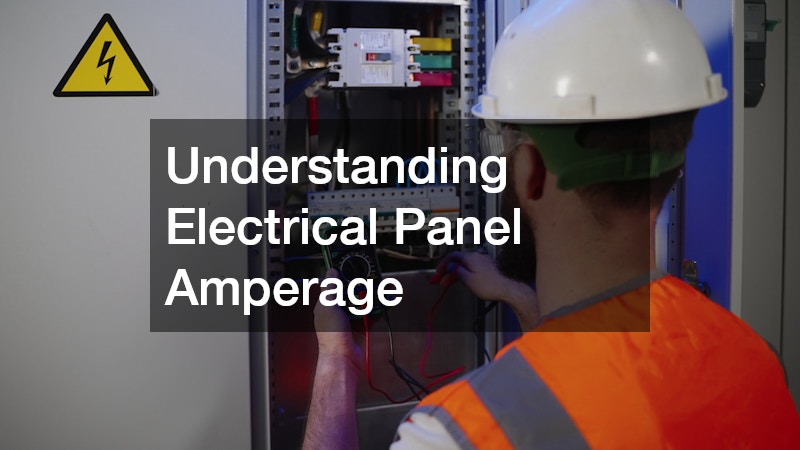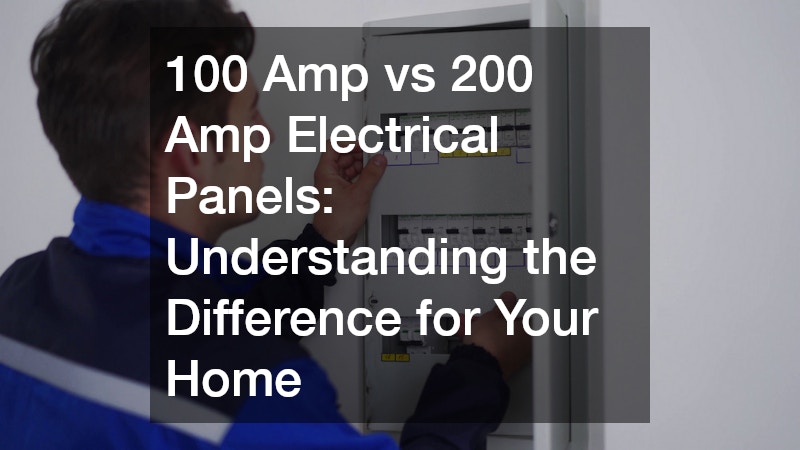When it comes to your home’s electrical system, one of the most important components is the electrical panel. This box serves as the hub that distributes electricity throughout your home safely and efficiently. Choosing the right electrical panel size, such as a 100 amp or 200 amp panel, is crucial to ensuring your electrical service meets the demands of your household. Understanding the difference between these two options can help you make informed decisions about your electrical system’s capacity, safety, and future needs.
What Is an Electrical Panel?
An electrical panel, sometimes called a breaker box or load center, is where the main power line from your utility company enters your home. It divides the electrical current into smaller circuits, which supply power to different parts of your house such as lighting, outlets, appliances, heating, and cooling systems. The panel contains circuit breakers that protect your wiring and devices by cutting off power if a circuit becomes overloaded or short-circuits.
Understanding Electrical Panel Amperage
The “amp” rating of a panel refers to the maximum amount of electrical current it can safely handle at one time. This rating indicates how much electricity your home can use without overloading the system.
-
100 Amp Panel: Can handle up to 100 amps of electrical current.
-
200 Amp Panel: Can handle up to 200 amps of electrical current.
While this might sound technical, it directly relates to how much electrical power your household can draw, which depends on the number and type of electrical devices and appliances you have.
Who Needs a 100 Amp Electrical Panel?
A 100 amp panel is typically suitable for smaller homes or older houses with modest electrical needs. Homes built several decades ago, or those with fewer electrical appliances and systems, often started with 100 amp service as standard.
If your home has:
-
Basic lighting and outlets
-
Standard kitchen appliances (oven, refrigerator)
-
Minimal or no electric heating and cooling systems
-
No high-energy devices like electric car chargers or hot tubs
Then a 100 amp panel may be sufficient to safely supply your electrical needs. It is designed to accommodate essential circuits and typical household demands without risk of frequent overloads.
Who Needs a 200 Amp Electrical Panel?
A 200 amp panel is more suited for modern homes or those with larger electrical demands. As technology advances, homes today use more electric devices, appliances, and systems that require more power to operate simultaneously.
A 200 amp panel is ideal if your home includes:
-
Central heating and air conditioning systems
-
Multiple large appliances (dishwasher, microwave, washer/dryer)
-
Electric vehicle charging stations
-
Home offices with computers and networking equipment
-
Advanced lighting systems or home automation
-
Hot tubs or pools with electrical features
This panel size offers the capacity to handle more circuits and higher electrical loads safely. It also provides more room for future expansion, so if you plan to add new electrical appliances or systems down the road, a 200 amp panel offers greater flexibility.
Key Differences Between 100 Amp and 200 Amp Panels
-
Capacity and Safety
The main difference lies in the amount of electrical power each panel can safely distribute. A 200 amp panel can deliver twice the current of a 100 amp panel. This means it can support more appliances running at the same time without risk of overloading circuits. Overloading can cause breakers to trip frequently or, in worst cases, pose a fire hazard.
-
Number of Circuits
200 amp panels generally accommodate more circuit breakers than 100 amp panels. More circuits mean more areas of your home can have dedicated power sources, which improves electrical efficiency and reduces strain on individual circuits.
-
Home Size and Electrical Load
Smaller homes or those with limited electrical usage often do well with a 100 amp panel. However, larger or newer homes with modern electrical demands benefit from the increased capacity of a 200 amp panel. This ensures the electrical service can keep up with daily usage without interruptions.
-
Future-Proofing
A 200 amp panel offers more flexibility for adding circuits or upgrading electrical equipment in the future. If you anticipate home expansions, new appliances, or more advanced technology, a 200 amp panel can save the hassle and expense of upgrading your panel later.
How to Know Which Panel You Have
The amperage rating of your electrical panel is usually listed on the door of the panel or inside the breaker box. It will be marked clearly, such as “100 AMP” or “200 AMP.” If you’re unsure, it’s best to consult a licensed electrician to inspect your electrical service and help determine the appropriate panel size for your home.
Signs You May Need to Upgrade From 100 Amp to 200 Amp
If your home currently has a 100 amp panel but you experience any of the following, it may be time to consider upgrading:
-
Frequent tripping of circuit breakers, especially when multiple appliances run at once.
-
Dimming lights when appliances are turned on.
-
Addition of large electrical devices such as electric vehicle chargers, HVAC systems, or hot tubs.
-
Home renovation or expansion that increases electrical demand.
-
Desire to install modern home technologies like smart lighting or security systems.
Upgrading to a 200 amp panel ensures your electrical service can handle these demands safely and reliably.
Choosing the right electrical panel is foundational to a home’s electrical safety and functionality. Whether you stick with a 100 amp service or upgrade to a 200 amp panel, understanding these differences will help you maintain a secure and efficient electrical system for years to come.




